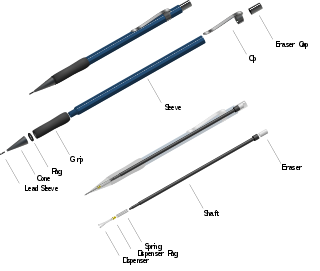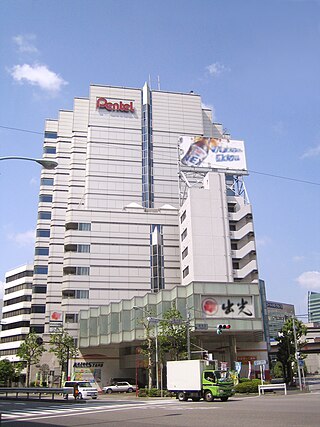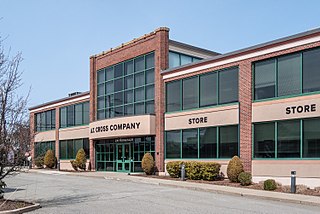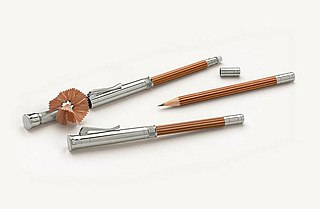
A ballpoint pen, also known as a biro, ball pen, or dot pen, is a pen that dispenses ink over a metal ball at its point, i.e., over a "ball point". The metal commonly used is steel, brass, or tungsten carbide. The design was conceived and developed as a cleaner and more reliable alternative to dip pens and fountain pens, and it is now the world's most-used writing instrument; millions are manufactured and sold daily. It has influenced art and graphic design and spawned an artwork genre.

A pen is a common writing instrument that applies ink to a surface, usually paper, for writing or drawing. Early pens such as reed pens, quill pens, dip pens and ruling pens held a small amount of ink on a nib or in a small void or cavity that had to be periodically recharged by dipping the tip of the pen into an inkwell. Today, such pens find only a small number of specialized uses, such as in illustration and calligraphy. Reed pens, quill pens and dip pens, which were used for writing, have been replaced by ballpoint pens, rollerball pens, fountain pens and felt or ceramic tip pens. Ruling pens, which were used for technical drawing and cartography, have been replaced by technical pens such as the Rapidograph. All of these modern pens contain internal ink reservoirs, such that they do not need to be dipped in ink while writing.

Caran d'Ache was the pseudonym of the 19th century Russian-French satirist and political cartoonist Emmanuel Poiré.
Ohto Co., Ltd. is a Japanese manufacturing company of writing implements. The company was established in 1919 as a manufacturer of dyes and ink. In 1949, the company became a pen manufacturer after they manufactured the world's first ball point pen with a chrome ball. This was also Japan's first ballpoint pen.

A mechanical pencil, also clutch pencil, is a pencil with a replaceable and mechanically extendable solid pigment core called a "lead". The lead, often made of graphite, is not bonded to the outer casing, and can be mechanically extended as its point is worn away as it is being used. The vast majority of mechanical pencils have erasers.

Pentel Co., Ltd. is a privately-held Japanese manufacturing company of stationery products. The name comes from one of their first widely known products and is a portmanteau of the English words pen and pastel. Pentel is also the inventor of non-permanent marker technology. Most Pentel products are manufactured in Japan, Taiwan, Korea, Mexico, and France.

Staedtler Mars GmbH & Co. KG is a German multinational stationery manufacturing company based in Nuremberg. The firm was founded by J.S. Staedtler (1800–1872) in 1835 and produces a large variety of stationery products, such as writing implements, art materials, and office supplies.

Rotring is a manufacturer of technical drawing tools and writing implements. Established in Germany in 1928 as a fountain pen manufacturer, Rotring went on to be acquired by Newell Brands in 1998. The name "Rotring" directly translates to "red ring" which is still placed around the barrel of their pens today. The company's name was changed to Rotring in the early 1970s to match the trademark.
Lamy is a German pen manufacturing company. Josef Lamy, who was a sales representative for Parker Pen in Germany, founded the business in 1930 by purchasing the Orthos pen manufacturer. Lamy was a pioneer in the use of moulded synthetic plastics to make their products.

Pilot Corporation is a Japanese pen manufacturer based in Tokyo, Japan. It produces writing instruments, stationery and jewelry, but is best known for its pens.
Uni-ball and Uni are brands of pens and pencils, made by the Mitsubishi Pencil Company Limited of Japan. The brand was introduced in 1979 as a rollerball pen model, then expanding to the rest of Mitsubishi Pencil products.

Zebra Co., Ltd. is a Japanese manufacturer of writing instruments, established in 1914 by Tokumatsu Ishikawa.

A.T. Cross Company, LLC. is an American manufacturing company of writing implements, based in Providence, Rhode Island. Founded in 1846, it is one of the oldest pen manufacturers in the world. Cross' products include fountain, ballpoint, and rollerball pens, mechanical pencils and refills. The company also manufactures accessories for those goods such as cases and wallets.
Ballograf AB is a Swedish manufacturer of writing implements. Ballograf manufactures its products from raw materials to finished product in its factory in Västra Frölunda, Gothenburg.
Eversharp is an American brand of writing implements founded by Charles Rood Keeran in 1913 and marketed by Keeran & Co., based in Chicago. Keeran commercialised Eversharp mechanical pencils, then expanding to fountain pens when the company was acquired by the Wahl Adding Machine Co. in 1916 and it was named "Wahl-Eversharp". The company continued until 1957 when it was acquired by Parker Pen, which continued to use the Eversharp brand for a time.

Graf von Faber-Castell is a brand of fine writing instruments from the German stationery manufacturer Faber-Castell. It includes a line of pencils, mechanical pencils, fountain pens, and rollerball pens. Currently, the Graf von Faber-Castell line includes high end writing instruments made with luxury materials such as ebony, resin, and ivory.

A colored pencil, coloured pencil, map pencil, pencil crayon, or coloured/colouring lead is an art medium constructed of a narrow, pigmented core encased in a wooden cylindrical case. Unlike graphite and charcoal pencils, colored pencils' cores are wax- or oil-based and contain varying proportions of pigments, additives, and binding agents. Water-soluble (watercolor) pencils and pastel pencils are also manufactured as well as colored cores for mechanical pencils.
Carole Hübscher Clements is a Swiss entrepreneur. She has been CEO of Geneva-based colored pencil and stationery manufacturer Caran d'Ache since 2012 and is the fourth generation to head the company. She also holds directorships at Mobiliar and precious metals specialist Cendres + Métaux. Hübscher is married and has three children.


















